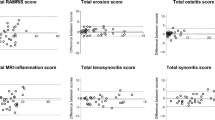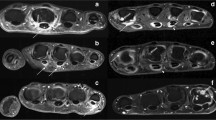Abstract.
The aim of this study was to assess the ability of MRI determined synovial volumes and bone marrow oedema to predict progressions in bone erosions after 1 year in patients with different types of inflammatory joint diseases. Eighty-four patients underwent MRI, laboratory and clinical examination at baseline and 1 year later. Magnetic resonance imaging of the wrist and finger joints was performed in 22 patients with rheumatoid arthritis less than 3 years (group 1) who fulfilled the American College of Rheumatology (ACR) criteria for rheumatoid arthritis, 18 patients with reactive arthritis or psoriatic arthritis (group 2), 22 patients with more than 3 years duration of rheumatoid arthritis, who fulfilled the ACR criteria for rheumatoid arthritis (group 3), and 20 patients with arthralgia (group 4). The volume of the synovial membrane was outlined manually before and after gadodiamide injection on the T1-weighted sequences in the finger joints. Bones with marrow oedema were summed up in the wrist and fingers on short-tau inversion recovery sequences. These MRI features was compared with the number of bone erosions 1 year later. The MR images were scored independently under masked conditions. The synovial volumes in the finger joints assessed on pre-contrast images was highly predictive of bone erosions 1 year later in patients with rheumatoid arthritis (groups 1 and 3). The strongest individual predictor of bone erosions at 1-year follow-up was bone marrow oedema, if present at the wrist at baseline. Bone erosions on baseline MRI were in few cases reversible at follow-up MRI. The total synovial volume in the finger joints, and the presence of bone oedema in the wrist bones, seems to be predictive for the number of bone erosions 1 year later and may be used in screening. The importance of very early bone changes on MRI and the importance of the reversibility of these findings remain to be clarified.
Similar content being viewed by others
Author information
Authors and Affiliations
Additional information
Electronic Publication
Rights and permissions
About this article
Cite this article
Savnik, A., Malmskov, H., Thomsen, H.S. et al. MRI of the wrist and finger joints in inflammatory joint diseases at 1-year interval: MRI features to predict bone erosions. Eur Radiol 12, 1203–1210 (2002). https://doi.org/10.1007/s003300101114
Received:
Revised:
Accepted:
Published:
Issue Date:
DOI: https://doi.org/10.1007/s003300101114




